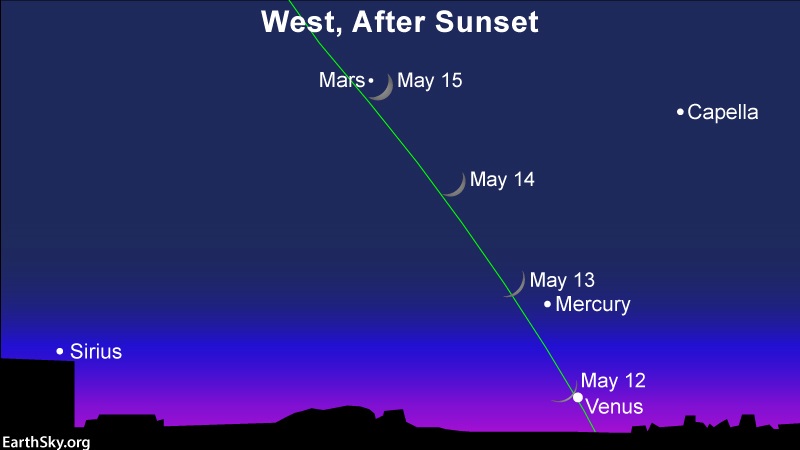Live in the Northern Hemisphere? If so, May 2021 presents your best month this year for spotting the planet Mercury – the solar system’s innermost planet, sometimes called the most elusive planet – in the evening sky. You can also catch Mercury from the Southern Hemisphere, though the view won’t be as favorable as at more northerly latitudes. From the Southern Hemisphere, the year’s best evening apparition of Mercury will be coming in September 2021.
No matter where you live worldwide, however, you’ll want to find an unobstructed horizon in the direction of sunset to maximize your chances of catching Mercury. Mercury, the innermost planet of the solar system, isn’t difficult to spot because it’s dim. Rather, Mercury often eludes detection, because it sits low in the west at sunset and then follows the sun beneath the horizon before true darkness falls. In other words, you have to catch Mercury near the sunset point on the horizon as evening dusk is giving way to nightfall.
Mercury shines at its brightest for the month in early May, and then slowly dims each day thereafter. Throughout the first week of May, Mercury actually shines at a negative magnitude, or brighter than a 1st-magnitude star. (Like in golf, where a lower number means a better score, a negative magnitude in astronomy indicates a brighter object.) But even as Mercury dims, it climbs farther away from the sun each day, to reach its greatest elongation from the sun on May 17, 2021. At that time, Mercury’s brilliance will match that of a 1st-magnitude star.

In other words, chances are that you may well see Mercury with the eye alone, despite the glow of evening twilight. Binoculars, though, always help out in any Mercury quest, especially if the viewing is a bit murky near the horizon. Even with ideal seeing conditions, binoculars enable you to catch Mercury all the sooner after sunset.
Given an absolutely unobstructed horizon in the direction of sunset, we give you Mercury’s approximate setting time for various latitudes:
60 degrees north latitude:
Early May: Mercury sets 1 hour and 55 minutes after sunset
Middle May: Mercury sets 2 hours and 50 minutes after sunset
Late May: Mercury sets 1 hour and 25 minutes after sunset40 degrees north latitude:
Early May: Mercury sets 1 hour and 15 minutes after sunset
Middle May: Mercury sets 1 hour and 55 minutes after sunset
Late May: Mercury sets 1 hour and 5 minutes after sunsetEquator (0 degrees latitude):
Early May: Mercury sets 55 minutes after sunset
Middle May: Mercury sets 1 hour and 30 minutes after sunset
Late May: Mercury sets 1 hour after sunset35 degrees south latitude:
Early May; Mercury sets 35 minutes after sunset
Middle May: Mercury sets 1 hour 10 minutes after sunset
Late may: Mercury sets 1 hour after sunsetFor more specific information, go to Old Farmer’s Almanac (U.S. and Canada) or TimeandDate (worldwide)
Starting the last week of May 2021, Mercury will dim to 2nd-magnitude, shining about 1/8 as brilliantly as it does in early May. Even so, Venus – the brightest of all planets – will shine rather close to Mercury on the sky’s dome in last week of May. So you can aim your binoculars at Venus to gaze at Mercury taking the stage with Venus in a single binocular field.
Most likely, you won’t see Venus early in the month, as this world sits rather close to the glare of sunset throughout the first week of May. Day by day, however, Venus will climb upward, away from the sunset glare. Finally, Venus will catch up with Mercury to showcase a close-knit conjunction on May 29 (evening of May 28 in the Americas).

Venus rates as the third-brightest celestial object to light up the heavens after the sun and moon. Because Venus beams so mightily, you can use brilliant Venus to locate faint Mercury in the latter part of the month. Mercury will become a faint 3rd-magnitude object by late May, or by the time of the Mercury-Venus conjunction on May 28 or 29 (depending on your time zone). So you’ll probably need binoculars for any chance of spotting Mercury next to Venus in late May.
Don’t tarry! Start looking for Mercury in the first few weeks of May, while this gleaming world is still bright and beautiful. Right now, in early May, Mercury shines some 40 times more brilliantly than it will by the month’s end.
Bottom line: Live in the Northern Hemisphere? If so, May 2021 presents the year’s best month for spotting the planet Mercury in the evening sky.











